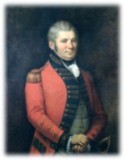
John Graves Simcoe

John Graves Simcoe
John Graves Simcoe was born on 25 February, 1752, in the village of Cotterstock, Northamptonshire, to John Simcoe, a captain in the Royal Navy, and Katherine Stamford. He was their third child, and the first to survive to adulthood. Eighteen years old, John enlisted in the 35th Foot Regiment in April 1770 instead of studying law at one of London's Inns of Court or pursuing a naval career in his father's footsteps.
The first four years of military life, spent in England, Ireland and Wales. were pleasant enough for Simcoe. He enjoyed a busy social life in his home city, Exeter, making friends with whom he exchanged correspondence while travelling the country with his regiment. Then in 1775, he was posted to Boston at the beginning of the American Revolution. He earned a promotion to Major after conceiving of a special light infantry designed to fight the Americans on even ground -- these were the Queen's Rangers, a loyalist unit who went into action in 1777. Major Simcoe participated in a number of operations in the New York and Virginia environs, being promoted to Lieutenant-Colonel by 1781, at which time he was sent home, sick and injured.
In 1782, Simcoe met Elizabeth Posthuma Gwillim, and the two married later that same year, creating a significantly wealthy estate. In the next eight years, five daughters were born to them -- Eliza, Charlotte, Henrietta, Caroline and Sophia -- and Simcoe entered Parliament. Then in 1791, Elizabeth finally gave birth to a son and suitable heir to the Simcoe estate: Francis. On 26 September, 1791, the Simcoe family left England for the New World, where Simcoe had been appointed Lieutenant Governor of the region of Upper Canada. On 11 November, they arrived in Québec and passed a harsh winter. In the spring, they travelled through Montréal and Montmorency on their way to the Niagara region, arriving in Newark (Niagara-on-the-Lake) on 8 June, 1792. Here, the seventh Simcoe child, Katherine, was born. Simcoe had been Lieutenant Governor for over a year at this point, and had not yet visited the site of York (Toronto). He did so on 26 August, 1793, naming the settlement after Frederick, Duke of York, the second son of King George III. Shortly thereafter, Katherine's health failed and she died, fifteen months old.
Sir Guy Carleton, then-Governor of Canada, had wanted a settlement at Toronto for years, having been urged by Montréal businessmen to regulate the Humber River fur trade, and having seen the need for a fortified harbour between Kingston and the Niagara peninsula. Additionally, the British Home Secretary believed that Toronto was more secure a location than Niagara-on-the-Lake for the colony's government. Simcoe directed the first draft of the city plan, and under his direction the site was surveyed and divided into lots, and a location for parliament buildings was decided upon. He was also instrumental in the formation of the first civil government in present-day Ontario. All the while, he was responsible for the maintenance of good relations with the Indians living in the territory ceded to the United States in 1783.
Simcoe did not remain long in Toronto or Upper Canada. In 1795, Simcoe sent his wife and children back to Québec, fearing that war would break out with the American colonies and endanger his family. The next year, they were reunited when Simcoe suffered a series of severe illnesses and terminated his appointment as Lieutenant Governor in September 1796, in order to recover and escape the frequent conflicts caused by contradictions between Simcoe's vague orders and those of Guy Carleton. The Simcoe family then sailed back to England.
Simcoe's command was changed from Upper Canada to Santo Domingo, where he was to restore order by handling a French invasion and staving off a slave rebellion. In 1797 he returned to England, where he was promoted to the rank of Major-General two years later and given command of the Plymouth garrison. In 1801 he was again promoted, gaining the title "Lieutenant General in command of coastal defense in Devonshire." Five years later, Simcoe was appointed commander of British forces in India; he was offered a position on a diplomatic mission to Portugal, but during the trip he became grievously ill. He returned quickly home to England, and died at his home in Exeter on 26 October, 1806. He was buried in Wolford Chapel on the family estate. The land containing the burial site has since officially designated part of the Province of Ontario.